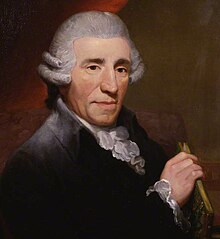Symphony No. 80 (Haydn)

The Symphony No. 80 in
Movements
The symphony is scored for flute, two oboes, two bassoons, two horns and strings and is in the typical four movements:
The first movement opens with a theme in the cellos accompanied by tremolos in the strings evoking a strong sense of
The lyrical second movement is in B-flat major and has little trace of the storminess of the opening movement,[3] although there are some darker passages toward the end of the movement.
The third movement returns to D minor with some emphasis on F major, like in the first movement. The trio is in D major and uses a derivative (almost the reverse) of the Gregorian incipit lamentatio melody previously used in his 26th symphony "Lamentatione".[4]
The finale is a sonata form in D major, with both halves marked for repeat.[5] There is a lot of syncopation throughout the movement,[6] particularly amongst the strings where the first violins play an eighth-note ahead of the second violins and the rest of the orchestra. The last movement contains very little negative melodies and ends with a passage similar to that he used to end his Symphony No. 84 in E♭.[2]
Notes
- ISBN 9780802868527.
- ^ ISBN 025333487X), pp. 203-206 (2002).
- ^ James Hepokoski og Warren Darcy, Elements of Sonata Theory (Oxford University Press: 2006) p. 328
- ^ H. C. Robbins Landon, Haydn: Chronicle and Works, 5 vols, (Bloomington and London: Indiana University Press, 1976-) v. 2, Haydn at Eszterhaza, 1766-1790
- ^ Anthony Hodgson, The Music of Haydn: The Symphonies (London: The Tantivy Press; Rutherford, Madison, Teaneck: Farleigh Dickinson University Press: 1976), p. 107
- ^ Rosemary Hugues, Haydn, The Master Musician Series, (London: J. M. Dent and Sons Ltd; New York: Farrar, Straus and Giroux, Inc., 1962, p. 184
External links
- "Press Release: Concert with Symphony No. 80 in D minor". L.A. Philharmonic. 2002-04-18. Retrieved 2018-10-14.
- Symphony No. 80 (Haydn): Scores at the International Music Score Library Project
